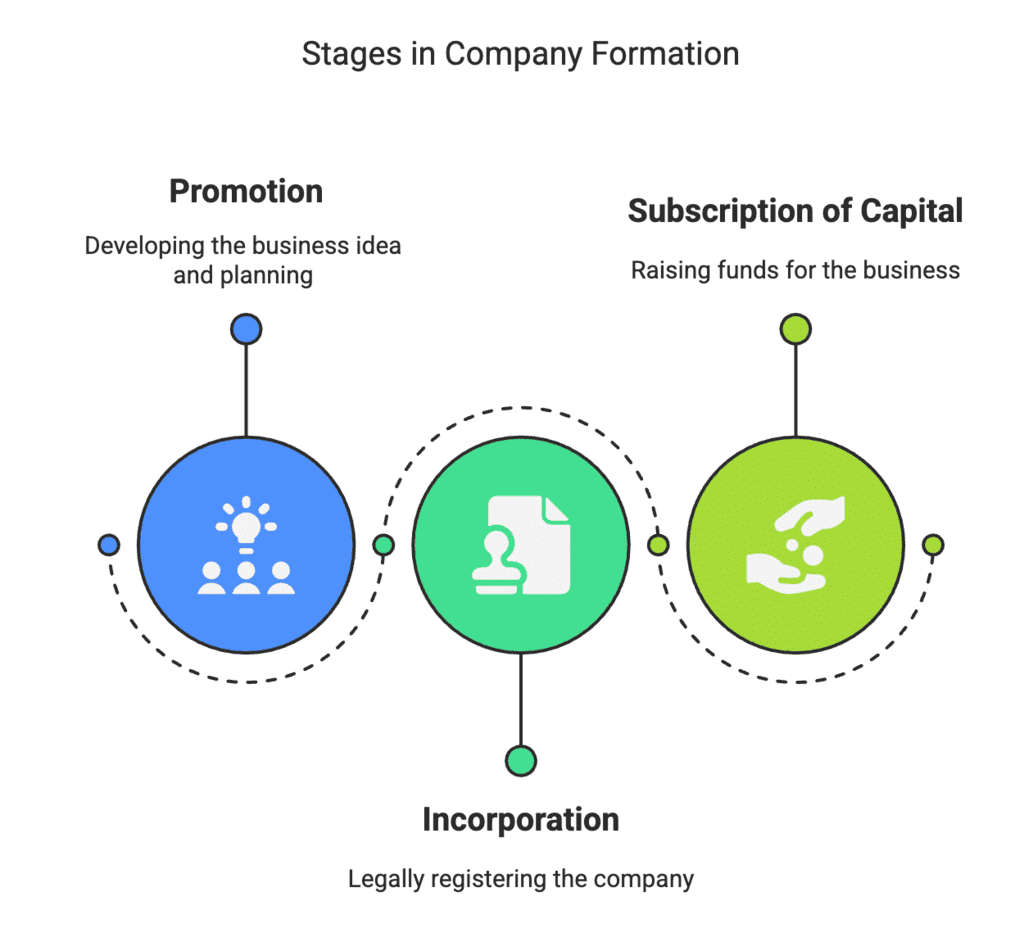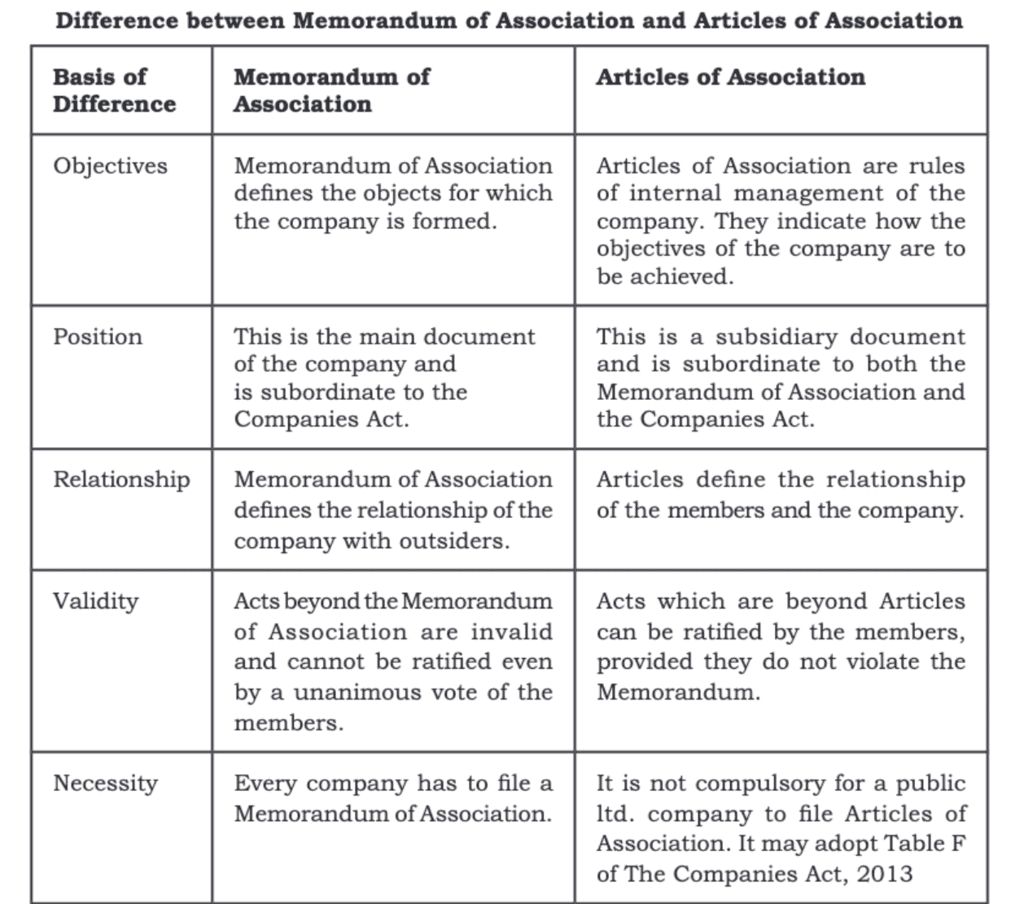Formation of a Company Chapter Notes | Business Studies (BST) Class 11 - Commerce PDF Download
| Table of contents |

|
| Promotion of a Company |

|
| Incorporation of a Company |

|
| Capital Subscription |

|
| One Person Company (OPC) |

|
Modern businesses need large amounts of money to grow. Due to increasing competition and rapid technological changes, business risks have also increased. Because of this, many businesses prefer to set up a company, especially for medium and large-scale operations.
Stages in Company Formation
The process of forming a company starts with a business idea and ends when the company is legally ready to operate. This process is called company formation. The people who take these steps and accept the risks involved are called promoters.
Company formation involves three main stages:
Promotion – Developing the business idea and planning.
Incorporation – Legally registering the company.
Subscription of Capital – Raising funds for the business.
A private company does not need to raise funds from the public, so it does not issue a prospectus or meet minimum subscription requirements.

Promotion of a Company
- Promotion is the first stage in company formation. It starts when someone finds a potential business idea and takes steps to turn it into a company. A promoter is a person or group that initiates the formation of a company by bringing together resources like money, materials, manpower, and management.
- Promoter: Promoter is a person who initiates the process of forming of company. He undertakes to form a company with reference to a given project and takes the necessary steps to accomplish the purpose. The promoter assumes responsibility for all matters relating to the formation of the company.

Functions of a Promoter
1. Identifying a Business Opportunity: The promoter looks for a business opportunity, such as:
- Introducing a new product or service.
- Finding a new market or improving an existing one.
2. Feasibility Studies: Not all ideas can become successful businesses. Promoters conduct studies to check if the idea is practical and profitable:
- Technical Feasibility – Checking if the required technology and raw materials are available.
- Financial Feasibility – Ensuring that enough funds can be arranged.
- Economic Feasibility – Confirming that the project will be profitable.
If the results are positive, the promoters move forward with company formation.
3. Name Approval: Promoters choose a unique company name and apply for approval from the Registrar of Companies. The name should not be misleading or too similar to an existing company name.
4. Selecting Signatories for the Memorandum of Association: The promoters select members who will sign the Memorandum of Association (MOA). These signatories often become the first directors of the company.
5. Appointing Professionals: Promoters hire experts like auditors and bankers to help with legal and financial procedures.
6. Preparing Legal Documents: Promoters prepare essential documents for company registration, such as:
Memorandum of Association (MOA) – Defines the company's objectives.
Articles of Association (AOA) – Specifies company rules and regulations.
Consent of Directors – Written approval from the first directors.
After completing these steps, the company is legally registered and ready to start operations.
Documents Required to be Submitted
To register a company, certain legal documents must be submitted to the Registrar of Companies. These include:
A. Memorandum of Association (MoA)
The Memorandum of Association defines the objectives of the company and outlines what activities it can legally undertake. As per Section 2(56) of the Companies Act, 2013, it includes the following clauses:
Name Clause: Specifies the approved name of the company.
Registered Office Clause: Mentions the state where the company’s office will be located. The exact address must be provided within 30 days of incorporation.
Objects Clause: Defines the purpose of the company. The company can only carry out activities mentioned in this clause.
Liability Clause: This clause states that shareholders are only responsible for the unpaid amount on their shares.
Example: If a shareholder owns 1,000 shares of ₹10 each and has paid ₹6 per share, their liability is limited to ₹4,000.
Capital Clause: Specifies the maximum amount of capital the company can raise and how it will be divided into shares.
Example: A company with an authorised capital of ₹25 lakhs may issue 2.5 lakh shares of ₹10 each.
At least seven people (for a public company) or two people (for a private company) must sign the MoA.
B. Articles of Association (AoA)
- The Articles of Association define the internal rules for managing the company. These rules must not contradict the Memorandum of Association.
- According to Section 2(5) of the Companies Act, 2013, companies can either adopt the standard format (Tables F–J in Schedule I) or create their own set of rules.
C. Consent of Proposed Directors
Each person listed as a director must submit a written consent confirming their willingness to serve and to purchase any required qualification shares as per the Articles of Association.
D. Agreement with Key Personnel
If the company plans to appoint a Managing Director, Whole-time Director, or Manager, any agreement regarding their appointment must be submitted.
E. Statutory Declaration
A declaration confirming that all legal registration requirements have been met must be submitted. This can be signed by:
An Advocate, Chartered Accountant, Cost Accountant, or Company Secretary involved in the company’s formation, or
A Director, Manager, or Secretary of the company.
F. Payment of Registration Fees
The registration fee depends on the authorised share capital of the company and must be paid along with the submission of the documents.
Position of Promoters
- Promoters carry out activities to get a company registered and ready to start business, but they are neither its agents (as it is not yet incorporated) nor its trustees. They are personally liable for pre-incorporation contracts unless the company later ratifies them.
- They hold a fiduciary position, meaning they must act in the company’s best interest, disclose any profits, and avoid secret gains. If material facts are concealed, the company can cancel contracts, recover payments, or claim damages.
- Promoters cannot legally demand reimbursement for promotion expenses, though the company may choose to repay them. They may also be compensated through lump-sum payments, commissions, shares, debentures, or options to buy securities later.
Incorporation of a Company
Once the necessary formalities are completed, promoters must file an application for incorporation with the Registrar of Companies (ROC) in the state where the company’s registered office will be located.
Documents Required for Incorporation:
Memorandum of Association (MoA): Signed by at least:
7 members (for a public company)
2 members (for a private company)
Articles of Association (AoA): Signed and stamped, or a Statement in lieu of AoA for public companies adopting Table A.
Consent of Directors: A written declaration agreeing to serve as directors.
Agreement (if applicable): For appointment of a Managing Director, Whole-time Director, or Manager.
Approval Letter from ROC: Confirming the company name.
Statutory Declaration: Confirming compliance with legal requirements, signed by an advocate, chartered accountant, cost accountant, or company secretary involved in forming the company.
Registered Office Address: Can be submitted within 30 days if not provided at incorporation.
Proof of Fee Payment: As per the authorised share capital.
Issuance of Certificate of Incorporation
Once the ROC verifies the documents, a Certificate of Incorporation is issued, which serves as the birth certificate of the company.
Since November 1, 2000, companies have also been issued a Corporate Identity Number (CIN).
The company legally comes into existence on the date mentioned in the certificate, regardless of any errors or fraud in the registration process.
Legal Effects of the Certificate of Incorporation
The company is a separate legal entity with perpetual succession.
It can enter into valid contracts immediately.
Once issued, the certificate is conclusive evidence of the company’s legal existence, even if there were irregularities in the registration.
Examples of Legal Recognition:
If documents were submitted on January 6 and the certificate was issued on January 8, but dated January 6, the company is considered legally formed on January 6.
If someone forged signatures on the Memorandum, the incorporation is still legally valid.
Certificate of Commencement of Business
Both public and private companies must obtain this certificate within 180 days of incorporation.
Without this, they cannot start business operations.

Capital Subscription
A public company can raise funds from the public by issuing securities (shares, debentures, etc.). To do so, it must issue a prospectus, inviting the public to subscribe to its capital, and complete several legal formalities.
Steps for Raising Funds from the Public
1. SEBI Approval
The Securities and Exchange Board of India (SEBI) regulates public fund-raising and protects investors.
Companies must disclose all relevant information and cannot hide any material facts.
Prior SEBI approval is mandatory before issuing shares to the public.
2. Filing of Prospectus
A prospectus is a formal document inviting the public to apply for securities or deposits in a company.
It must contain accurate and complete information to help investors make informed decisions.
A misstatement in the prospectus can lead to legal consequences.
3. Appointment of Bankers, Brokers, and Underwriters
Bankers: Handle the receipt of application money from investors.
Brokers: Distribute application forms and promote share sales to the public.
Underwriters (optional): Guarantee the purchase of unsold shares and receive a commission for their service.
4. Minimum Subscription
A company cannot proceed with share allotment unless it receives applications for at least 90% of the issue size (as per SEBI guidelines).
If this minimum subscription is not met, the company must refund the money to applicants.
5. Application to Stock Exchange
A company must apply to at least one stock exchange for permission to list its shares or debentures.
If permission is not granted within 10 weeks of closing the subscription list, the allotment becomes void, and the company must return all application money within 8 days.
6. Allotment of Shares
Application money must be kept in a separate bank account until shares are allotted.
If an applicant receives fewer shares than applied for, excess money is either refunded or adjusted toward the allotment amount.
An allotment letter is sent to successful applicants.
A Return of Allotment, signed by a director or secretary, must be filed with the Registrar of Companies within 30 days.
Alternative to Public Issue
A public company may choose not to invite the public for funding. Instead, it can raise capital from:
Friends, relatives, or private investors
Private placements, similar to how a private company operates
In such cases, a prospectus is not required, but a Statement in lieu of Prospectus must be filed with the Registrar at least 3 days before allotment.
One Person Company (OPC)
The Companies Act, 2013, introduced the concept of a One Person Company (OPC), allowing a single person to form a company. This reform aims to promote entrepreneurship and corporatisation of micro-businesses by offering a simpler legal structure with fewer compliance requirements.
Background
The JJ Irani Expert Committee (2005) recommended OPCs to support small entrepreneurs by reducing legal complexities.
OPCs offer benefits similar to private limited companies, such as:
Separate legal entity (the company is distinct from its owner).
Limited liability (personal assets are protected).
Perpetual succession (the company continues even after the owner's death).
Key Characteristics of OPC
1. Eligibility Criteria
Only a natural person who is an Indian citizen and resident in India can:
a) Incorporate an OPC.
b) Be a nominee for an OPC member.A resident in India is someone who has stayed in India for at least 182 days in the previous year.
2. Restriction on Multiple OPCs
A person can incorporate only one OPC or be a nominee in only one OPC at a time.
If a person becomes a member of another OPC due to nomination, they must resolve this within 180 days.
3. Restrictions on Membership
Minors cannot be members, nominees, or hold beneficial shares in an OPC.
4. Conversion Limitations
An OPC cannot be incorporated or converted into a Section 8 company (charitable company).
It cannot engage in Non-Banking Financial Investment (NBFC) activities, such as investing in securities.
Voluntary conversion into another type of company is not allowed before 2 years, unless:
The paid-up capital exceeds ₹50 lakh OR
The annual turnover exceeds ₹2 crore.
|
38 videos|264 docs|28 tests
|
FAQs on Formation of a Company Chapter Notes - Business Studies (BST) Class 11 - Commerce
| 1. What is the process of company registration? |  |
| 2. What documents are required for company registration? |  |
| 3. How can a company promote its products or services? |  |
| 4. What is the process for trademark registration? |  |
| 5. How important is employee training and development in a company? |  |
















